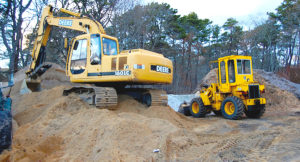The question: We renovated our modest cottage in Wellfleet to make it our year-round home. But now that the job is done, we are wishing we had thought more about the site itself. The construction was hard on the surrounding landscape. What could we have done differently? How do we start setting things right without spending a fortune?
Experience has taught Thomas Edwards that careful site planning saves a lot of aggravation, time, and money. Edwards opened his landscaping business in Wellfleet in 2009 after 20 years doing excavation and building projects.
“You can’t just go to a site and start clearing,” Edwards says. “Before a shovel hits the ground there should be a sensible plan in place.”

Even before planning begins, Edwards points out, it’s important to check with your town’s building department to find out what might be required, especially if you’re near wetlands or conservation areas — which is quite likely here on the Outer Cape.
Knowing the rules also helps you shape your vision for the property while abiding by regulations that protect the natural environment. It’s a process that must be dealt with, Edwards says, but it’s helpful. It’s better than developing a plan that can’t happen and that leaves you fighting the limitations of your land.
Let’s assume you got your project done by following those rules. Even so, Edwards says the post-construction terrain can still look disconcertingly bare and beat up. It can be tempting to just start planting. But it’s better to wait.
Thomas Edwards now works with his son Chad, who has an eye for landscaping. Chad’s advice is that early on you should try and determine how plants will function in your landscape. But even after construction or renovation has been done, it’s not too late to develop an overall vision for your property.
Start by considering your topography and soil. The best landscape designs will take these into account to promote moving water away from your house to preserve the foundation.
When it comes to larger trees, remember that it’s important to preserve some open space close to the house itself, Chad and Thomas say. Maintaining a 25-foot buffer for groundcovers and lower plantings will protect your house in a couple of important ways.
If your house doesn’t have room to breathe and dry out in the sunlight, then you’re just trapping moisture. And overhanging branches can cause mold spores to grow on the roof or can come down in storms and do damage.
A third step in planning the landscape is to take into account how the passage of time will affect your plantings. It’s important to give shrubs and trees enough room to reach their mature size.
“You can pretty things up as much as you want,” Chad says. But it is this type of site planning that helps you accomplish the ultimate goal of settling your home into the larger natural setting around you.
Thomas Edwards is from Provincetown and has been doing construction, landscaping, and site work for over 30 years. He now lives and works in Wellfleet, where he and his son Chad are the owners of T.A. Edwards & Son.



